That drizzle is no good for just mossy rooftops and plush greenery. During the months between October and May, rain falls steadily across the metro area, seeping into crawl spaces where unwanted tenants find a place to call home. Rats and mice not only put up with Portland’s damp climate, but also flourish in it, burrowing under homes where moisture builds up and heat seeps down from above.
From Sellwood to St. Johns, homeowners are finding shredded insulation, contaminated vapor barriers, and telltale droppings in places they seldom look. Oregon winters are mild, and with that, and the near-constant rain, year after year, the rodents grow.
And sure, you can not manipulate the weather, but you can manipulate crawl-space weaknesses. We know basements and crawl spaces are ideal homes for rodents, especially when Portland’s drizzle makes them seek warm shelter, which can jeopardize property and household health. Professional pest management from pointepest.com is needed.
The Crawl Space: Portland’s Perfect Rodent Refuge
Crawl spaces under Portland houses are ideal places for rodents to set up shop. These dark, enclosed areas provide:
- Defending oneself against the predation of the urban forests of Portland by stalking owls and hawks
- Temps that remain steady in the 50-60°F range, even in the coldest January weeks
- Tons of nesting materials made from fiberglass insulation and cardboard storage bins
- Gaps giving them easy access into kitchens and pantries make it easy for them to get to their food sources
How the Drizzle Drives Rodents Indoors
Portland’s annual rainfall is 43 inches, most of it between November and March. This continuous wetness forces rodents to forsake burrows outside that repeatedly drown. Norway rats, which are ubiquitous in Multnomah County, will automatically climb when their burrows begin to fill with water.
Basements turn into emergency camps that soon become permanent homes. Wet weather similarly limits outdoor food; wet ground means fewer seeds are available, as they cannot be accessed, and trash is harder to scavenge. A home heated from above sends a signal to the crawl space floor that resources are plentiful by radiating warmth upward.
Prevention Strategies for Rainy-Season Rodent Control
Seal Entry Points Before October
Homeowners in Portland should check the foundation, utility penetrations, and crawl space vents before fall rains begin. The Multnomah County health data shows that calls for rodent services are up 34% from October to December, when rodents move indoors in search of shelter. Use steel wool and caulk to seal gaps; replace broken vent screens; and place door sweeps on exterior entries.
Manage Moisture Proactively
Vapor barriers are installed over crawl space flooring to reduce humidity levels that attract rodents. Gutters should be set back 6 feet from foundations. The dense clay soils of Portland can retain moisture, creating a moist perimeter that gives rodents a direct path into entry points. Dehumidifiers can help lower relative humidity to below 60%, making environments unfriendly for them.
Maintain Yard Hygiene
Clear away vegetation from foundations and debris piles where rodents nest before attempting entry into houses. The abundant rodent cover provided by Portland’s landscaping offers fewer opportunities to approach when a three-foot clearance is maintained.
When DIY Fixes Aren’t Enough
Portland crawl spaces are characterized by established rodent colonies that are rarely affected by hardware-store traps or over-the-counter repellents. Over generations, the city rat families have become urban dwellers, developing an innate wariness of rudimentary pest-control techniques. Experience is critical.
Construction imperfections that are not visible to the naked eye allow rodents access, and there are literally thousands of potential passage points in Portland’s older housing stock. In Portland crawl spaces, established rodent colonies are rarely deterred by hardware-store traps or over-the-counter repellents.
Pointe Pest Control offers rodent exclusion services throughout the Portland metro area. Using thermal imaging, they thoroughly inspect crawl spaces for active nesting sites and entry corridors. They employ technicians who understand how rodent behavior may vary in your area and how the unique Portland climate can affect it..

